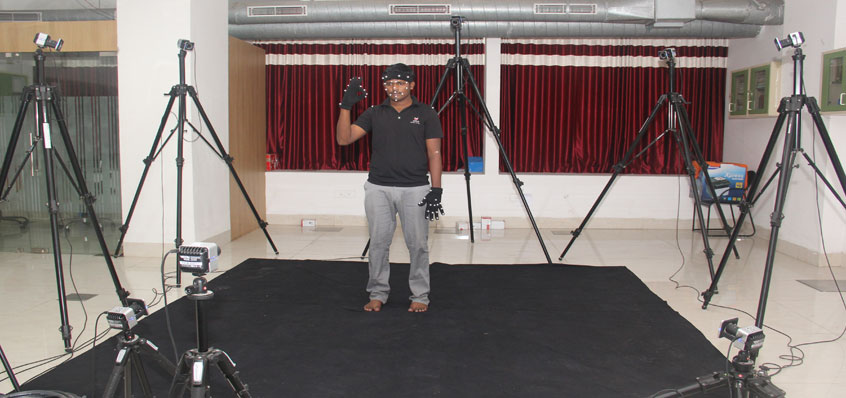
Biomechanics & Vision Computing Research Centre (BVCRC)
Fostering needs of Hearing Impaired and Elderly
The Biomechanics research laboratory of the Electronics and Communication department was set up in the year 2016 under the DST-TIDE program with an initial fund of 62.5 lakhs to perform extensive research on humans and their activities to develop an effective sign language system that can add significant value to the lives of people
This research lab is supervised by Professor, Dr. PVV Kishore and is co-supervised by Dr. ASCS Sastry. The Biomechanics lab with a team of 7 people, with 2 Assoc. Professors and 3 Research scholars takes charge of various internal and external projects
Various research activities are extensively performed in this Biomechanics laboratory using motion capture technology which includes real-time Indian sign language recognition, Human action recognition, real-time Indian classical dance education, Flower Classification, and Train Rolling stock examination. In addition, the Biomechanics lab also explores other applications of Motion Capture Technology
The Biomechanics lab has Vicon motion capture, state-of-the-art technology that captures movements in a 3-Dimensional environment. For tracking and analyzing the movement of humans and developing sign language from the data, the Biomechanics department used this motion picture technology. These 8 Vicon Vero model cameras are assisted with one DVI camera to take care of the task of recording movements of human motions in 3D mode. The technology is widely used in various animations and movie productions, the life sciences industry, and even in the sports Industry. In sports biomechanics, especially cricket, Biomechanics is used to improve the player’s performance in batting and bowling and to check the legitimacy of the bowling
Data Collection
The data collection and deciphering, to make an effective language system begins by choosing the subject of concern. Once the subject (for example human) is chosen, then he is fixed with sensors on the body parts where motion needs to be captured. The sensors capture the animation with various cameras to process the data. The laboratory takes pride in collecting human movement’s data of 102 human actions ranging from answering the call to throwing a javelin with various 3.2 MP cameras in a frame rate of 320fps, naming it as KLHA3D-102 dataset. We are sure Neeraj Chopra; Olympic Javelin throw winner can be assisted with our Biomechanics lab to enhance his performance further
The camera heights and subjects’ positions were generalized by five human subjects who participated in this data collection. KLYoga3D, another data set involving 3 human subjects is performed on Yoga practice. The motion capture database at the laboratory KLHA3D and KLYoga3D supply free motion capture data for various research purposes. The KLHA3D-102 and KLYoga3D databases have been designed and set up under the direction of Dr. P.V.V.Kishore
Milestones Achieved
- Sign language in 3D - First in the entire world
- 2016 Established, funded by DST-TIDE- 62.5 Lakh capital
- Publications in BIH journals
- 3D Humans data procurement done
- 10 3-D motion cameras & 1 Vision camera
- Slow-motion capture technology
- Multidimensional Imaging Technology
- Machine learning & Deep learning developed apps
- Deep learning into a mobile platform
The slow-motion and multidimensional imaging technology with the department is used various specimens to develop a deeper understanding of various subjects. The futuristic vision of the department is to develop an effective sign language system that is 3D Mode. The data that the department is developing is used to develop various applications. The research lab aims to develop many more human-centric solutions that can be extremely useful for society.